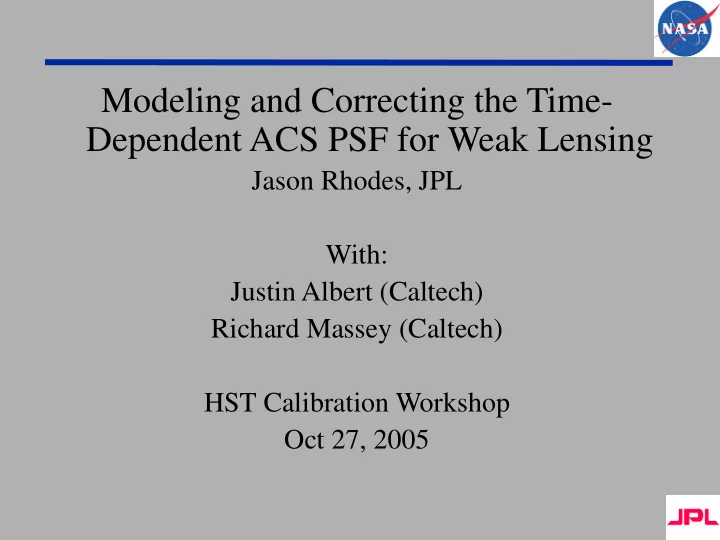

Modeling and Correcting the Time- Dependent ACS PSF for Weak Lensing Jason Rhodes, JPL With: Justin Albert (Caltech) Richard Massey (Caltech) HST Calibration Workshop Oct 27, 2005
Motivation :Weak Lensing •Statistical measurement on many galaxies •Lensing induced ellipticities 1-2% •Telescope Point Spread Function (PSF) is the primary systematic concern –it changes shape (e)!
Two Main Problems 1.Aliasing of the PSF during distortion correction re-pixellization (Multidrizzle) 2.Time variation of PSF due to thermally induced focus changes
Data Sets • Cosmos 2 Square degree field — Taken cycles 12-13 — 590 orbits of F814 Not enough stars per field to model PSF • ACS Parallels — Taken cycles 11-13 — 500 fields of F775W Not take • Stellar Fields (globular clusters) often enough — Taken cycles 11-13 to account for — A few fields in F775W and F814W time variation
TinyTim • TinyTim Version 6.3 written by John Krist ( http://www.stsci.edu/software/tinytim/tinytim.html ) • Creates a PSF anywhere on the ACS chip with any filter and spectrum • Can be highly oversampled • Includes diffraction, distortion and charge disffusion • Produces stars as we see in raw (distorted) ACS images
How We Use TT • We use F814W filter, and single wavelength 800nm • We modify the code to measure the effects of multidrizzle • We created a version of multidrizzle that only adds distortion across the field • We modify the code to produce undistorted (post multidrizzle) stars • We manually add charge diffusion as a convolution with a distorted kernel • We avoid the complications of multidrizzle on our model stars
Aliasing From Multidrizzle
“Aliasing” from pixellization Unfortunately, a star’s sub-pixel position affects its observed shape.
“Aliasing” from second Pixellization Then it happens again during DRIZZLE! This at least must be avoidable…
Adjust Pixel scale & DRIZZLE kernel …it is!
Recommended Multidrizzle Parameters •Created TinyTim models with same diffraction everywhere, only distortion is different •Run through multidrizzle w/ various parameters •Large improvement going from 0.05 to 0.03 arcsecond pixels •Gaussian kernel has lower RMS(e) and is more stable 0.011 0.01 0.009 0.008 RMS e Square kernel 0.007 Gaussian Kernel 0.006 0.005 0.004 0.003 0.002 0.015 0.025 0.035 0.045 0.055 Pixel Scale
The PSF Problem The PSF pattern is time dependent
Periodic Focus Variation •COSMOS data •~20 day time scale •Determined by fitting to TinyTim models
Our Solution •Not enough stars → Make our own! •Use TinyTim PSF modeling software •Create stars without geometric distortion (but with diffraction and other PSF effects •Required modification of TinyTim program •Create dense stellar grids (up to 50x50 across field) •Create at range of focus positions (-10 to +5 μ m) •Use stars in each COSMOS field (~10 to 20) to pick the best focus value •Use the template at that focus value to perform correction •Eliminates need for interpolation between stars
TinyTim- The PSF Solution From ISR ACS 2003-6
Focus Values in COSMOS Focus values cluster!
COSMOS Results Before TT E B modes modes After TT
Remaining Work and Conclusions • Still some work to be done — mapping chip height variations with globular clusters — TinyTim stars still slightly too small (diffusion convolution?) — What effect does CTE have on the PSF? — Compare to other methods (e.g. principle component analysis; see Jarvis and Jain astro- ph/0412234 ) • Method greatly reduces PSF systematics • Can easily be extended to other filters • Useful for more than weak lensing
Recommend
More recommend